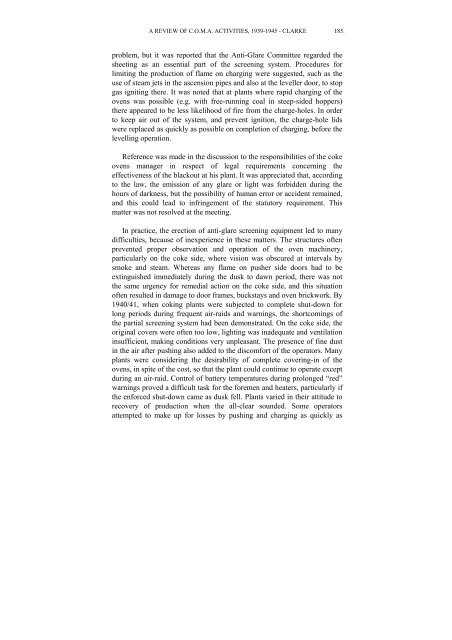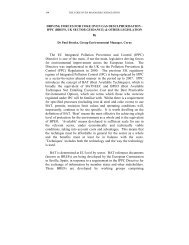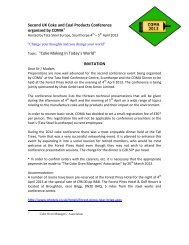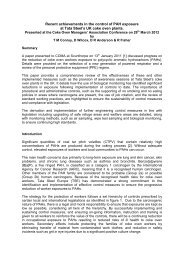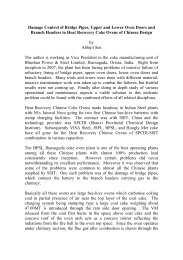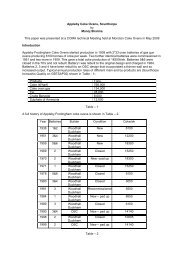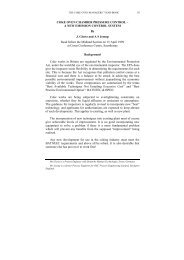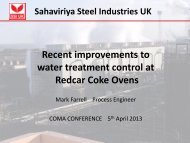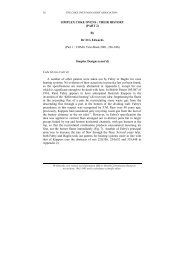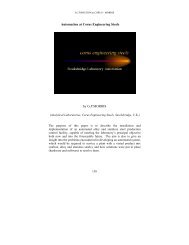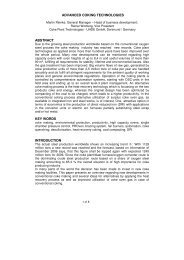CHAIRMAN'S ADDRESS - Coke Oven Managers Association
CHAIRMAN'S ADDRESS - Coke Oven Managers Association
CHAIRMAN'S ADDRESS - Coke Oven Managers Association
- No tags were found...
You also want an ePaper? Increase the reach of your titles
YUMPU automatically turns print PDFs into web optimized ePapers that Google loves.
A REVIEW OF C.O.M.A. ACTIVITIES, 1939-1945 - CLARKE 185.problem, but it was reported that the Anti-Glare Committee regarded thesheeting as an essential part of the screening system. Procedures forlimiting the production of flame on charging were suggested, such as theuse of steam jets in the ascension pipes and also at the leveller door, to stopgas igniting there. It was noted that at plants where rapid charging of theovens was possible (e.g. with free-running coal in steep-sided hoppers)there appeared to be less likelihood of fire from the charge-holes. In orderto keep air out of the system, and prevent ignition, the charge-hole lidswere replaced as quickly as possible on completion of charging, before thelevelling operation.Reference was made in the discussion to the responsibilities of the cokeovens manager in respect of legal requirements concerning theeffectiveness of the blackout at his plant. It was appreciated that, accordingto the law, the emission of any glare or light was forbidden during thehours of darkness, but the possibility of human error or accident remained,and this could lead to infringement of the statutory requirement. Thismatter was not resolved at the meeting.In practice, the erection of anti-glare screening equipment led to manydifficulties, because of inexperience in these matters. The structures oftenprevented proper observation and operation of the oven machinery,particularly on the coke side, where vision was obscured at intervals bysmoke and steam. Whereas any flame on pusher side doors had to beextinguished immediately during the dusk to dawn period, there was notthe same urgency for remedial action on the coke side, and this situationoften resulted in damage to door frames, buckstays and oven brickwork. By1940/41, when coking plants were subjected to complete shut-down forlong periods during frequent air-raids and warnings, the shortcomings ofthe partial screening system had been demonstrated. On the coke side, theoriginal covers were often too low, lighting was inadequate and ventilationinsufficient, making conditions very unpleasant. The presence of fine dustin the air after pushing also added to the discomfort of the operators. Manyplants were considering the desirability of complete covering-in of theovens, in spite of the cost, so that the plant could continue to operate exceptduring an air-raid. Control of battery temperatures during prolonged “red”warnings proved a difficult task for the foremen and heaters, particularly ifthe enforced shut-down came as dusk fell. Plants varied in their attitude torecovery of production when the all-clear sounded. Some operatorsattempted to make up for losses by pushing and charging as quickly as


